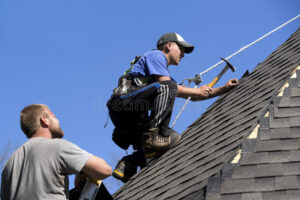Sealcoating extends the life of asphalt pavement for minimal cost. It prevents oxidation, stops weather damage, and prevents unsightly and dangerous potholes from forming.
Refined coal tar is the crucial ingredient in most sealcoats. It binds the other elements together and gives the product its deep black color. The other ingredients help with drying time, altering sand suspension, improving flexibility, and resistance to salts and petrochemicals. Visit https://www.rochesternysealcoating.com to learn more.
Seal coating can help asphalt look brand new, and it can fill in cracks or small holes. However, it doesn’t stop water from damaging pavement or prevent aging and oxidation of blacktop. Fortunately, there are ways to slow the damage and keep your asphalt looking great longer.
One of the most common mistakes DIYers make is not blocking off the area to be sealed. Workers need a clear path to the asphalt surface, so this step is vital. The surface also needs to be clean and dry so that the seal coat bonds properly with the asphalt. This means that blowers or brooms will need to be used to clear away debris like dirt, leaves, and other loose material.
Workers should then sweep the entire area to ensure that any remaining debris is removed. This is particularly important in areas that experience a lot of rain, as the surface must be completely dry before sealing can take place.
After the surface is clean and dry, workers will spray a thick layer of the sealer onto the surface. They will then spread it evenly using brushes and squeegees, which helps ensure that the material fills in any cracks or holes. Once the sealer has been applied, workers will let it dry for 24 hours before vehicles can drive on the surface.
The best way to avoid the pitfalls of DIY sealcoating is to hire a professional for the job. Professionals have years of experience and know how to prepare and apply a seal coat that will last. They can also save you money in the long run by avoiding expensive repairs and replacements. In fact, it is estimated that it costs 75% less to maintain a driveway or parking lot with a seal coat than it does to repair and replace asphalt. This is especially true if you regularly schedule seal coatings every few years. If you wait too long between applications, your sealcoat may start to deteriorate quickly and cost more in repairs. In addition, you may not get the same level of protection from UV rays and other environmental factors.
Preparation
Asphalt pavement is essentially rock and stone, held together by a substance called “binder” (created from the distillation of certain crude oils). Sealcoating is important because it helps to protect the binder from degradation. Over time, water, UV rays and other elements begin to break down the binder, which leads to deterioration of the surface. Regularly scheduled sealcoating extends the life of the asphalt, which in turn saves money on repaving costs down the road.
The first step in preparing for the asphalt sealcoating process is to thoroughly clean the area. The pavement must be free of debris, dirt and oil stains to ensure that the coating will bond properly. Once the area is cleaned, it should be inspected for any needed repairs. Crack filling and patching are essential asphalt paving repair steps that should be completed before any sealcoating is applied.
After the repairs are complete, a chemical stripper is used to remove any oil or grease spots that may be present on the asphalt. Then, the paved surface is vacuumed to remove any remaining debris or dirt. Once the surface is dry, a primer compound is applied to the paved area to help the sealer adhere to the surface. Then, the asphalt sealer is applied in two applications using state-of-the-art spray application equipment. Any areas that require a little extra work, like the trim, are brushed by hand to minimize the risk of overspray onto sidewalks, curbs or buildings.
Once the two coats of sealer are applied and allowed to dry, the paved area will be ready for traffic. A layer of sealer creates a smooth, black surface that looks brand-new and improves the curb appeal of the property. In addition, a smooth, uncracked pavement is easier to keep clean and clear of debris.
Pavement that is regularly sealed can stay in good condition for up to double the lifespan of untreated asphalt, saving money on costly repaving down the road. The minor labor involved in applying a layer of sealer is well worth it to protect the asphalt investment and keep the property looking its best.
Application
A specialized layer of liquid protects asphalt surfaces from the elements that cause it to become brittle. Water, UV rays, chemicals from motor oil and gasoline leaks, and vehicular traffic wear away at the binding agent in asphalt. The loss of the binder eventually causes cracks and surface holes to form. Seal coating keeps these elements out and stops them from deteriorating the asphalt further, which extends its life and prevents costly repairs.
Workers apply the seal coat using spray hoses, self-propelled squeegee machines, or by hand with brushes and squeegees. The sprayed material needs to be evenly distributed for best results. To do so, the workers need to sweep and blow off any loose debris before applying the seal coat. Once the application process is complete, workers need to block off the area where they have been working from any traffic or pedestrians. This will keep them safe and ensure that no one steps on the newly applied asphalt while it is still curing.
Once the pavement has been sealed, it will need to be allowed to dry for up to 24 hours before traffic is allowed back onto it. If striping for parking spaces is required, it can be done once the pavement has fully cured. It is also a good idea to remove any barricades that have been placed in the parking lot during the process and to take down any signs that may be standing on the paved surface.
It is important to note that sealcoating does not repair existing damage to the asphalt. It is intended to act as a protective layer and stop the deterioration that will otherwise result in potholes and void the warranty on your new asphalt. It is much more cost effective to regularly apply sealcoating than it is to have a section of your asphalt replaced completely. However, it is a good idea to have your asphalt repaired and sealed as soon as you see any signs of damage. This will limit the amount of time that it takes for the sealcoat to prevent further damage and save you money in the long run.
Maintenance
Asphalt pavements are made up of rock and/or stone and gravel, held together by a binder that is derived from the distillation of certain crude oil products. Over time, rain and UV rays degrade this binder, which causes the surface to deteriorate and eventually crack. The seal coat prevents this process by creating a tough, long-lasting protective layer. It also improves the appearance of the asphalt by restoring its dark, glossy black color.
A high-quality sealcoat will last up to 10 years, but it’s important to perform maintenance every year in order to get the most life from your asphalt pavement. When you hire a professional to complete this service, they will be able to recommend the best times of year to apply the sealant for your particular climate and conditions.
Before applying any type of sealcoat, the pavement must be thoroughly cleaned. This includes removing any oil stains with a chemical treatment, power washing the area, and broom sweeping all debris from the surface. Linear cracks should be filled with hot rubberized crack filler before sealcoating. Then, the asphalt surface should be broom swept again to ensure a smooth, even application of the sealant.
It’s recommended to have professionals perform this task, as they will be able to use specialized equipment and pressurized sprayers to ensure an even application. They will also be familiar with the product manufacturer’s individual instructions on application, which will save you time and frustration. If you decide to do the project yourself, make sure you have the proper safety gear, as coal tar emulsions can cause skin and lung damage.
If you would like to learn more about the benefits of asphalt seal coating, contact Rose Paving today! We’re a nationwide team of paving experts, and we can help you identify the optimal time of year to perform a pavement assessment and get started on your sealcoating project. You can expect your asphalt surfaces to double their life and resist further damage from harsh weather, sun exposure, water penetration, and heavy traffic after the seal coat is applied.

